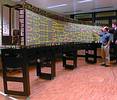5700 programmable chips enable revolutionary 'self regenerating electronic tissue' display
24 September 2003
News

Information from Memec SA
At the International Workshop on Information Processing in Cells and Tissues (IPCAT 2003) this month, the Logic Systems Laboratory (LSL) of the Swiss Federal Institute of Technology (EPFL) used 5700 Xilinx Spartan FPGAs to develop a self-repairing electronic tissue and interactive display called ‘the BioWall’.
The BioWall combines the latest in digital technology with the most instinctive of human gestures - touch. The creation of the BioWall is said to be a major step towards the creation of intelligent, bio-inspired electronic tissues, capable of evolving, self-repairing, self-replicating and learning. It will be displayed at the ITU Telecom World 2003 exhibition in Geneva, in October.
BioWall was designed to demonstrate the features of Embryonics (embryonic electronics) to the public, through a visual and tactile interaction. Visitors can participate in a selection of activities designed to demonstrate the chameleon-like qualities of the electronic tissue. Because Xilinx Spartan FPGAs are reprogrammable, they act as self-repairing receptors, much like those in human skin, with the ability to 'heal' or change in response to stimuli from the outside world - such as touch.
With thousands of potential uses, the use of self-regenerating, highly robust electronic tissue is likely to become widespread, says the EPFL, particularly where dependability is absolutely paramount, such as space exploration. The technology will also pave the way for even more intelligent automated machines such as ATMs, gas pumps, and ticket, food, and drink dispensers.
EPFL researchers have only begun to explore the possibilities of the BioWall as a research tool. Thus far they have developed a few such applications, designed to exploit the versatility inherent in its programmable architecture. The size of the BioWall display allows an immediate interaction with applications that are normally limited to software simulation on a computer screen and the computing power and programmability of the FPGAs allow the prototyping of new bio-inspired systems.
To see information on the creation and development of the BioWall, go to http://lslwww.epfl.ch/biowall. For the full story on the role of Xilinx Spartan FPGAs in its development go to www.xilinx.com/publications/xcellonline/xcell_47/xc_pdf/xc_biowall47.pdf.
For more information contact Kobus Botes, Memec SA, 011 897 8600, [email protected]
Further reading:
Electronic News Digest
News
A brief synopsis of current global news relating to the electronic engineering fields with regards to company finances, general company news, and engineering technologies.
Read more...
4000 A containerised DB for power project
News
Power Process Systems has successfully completed the design, fabrication, and commissioning of a 4000 A containerised distribution board for a wind/PV solar hybrid renewable energy project.
Read more...
Datacentrix Industrial Indaba 2025
News
Datacentrix recently hosted its inaugural Industrial Indaba 2025, where industry leaders explored how digitalisation, resilience, security and compliance are shaping the future of sustainable industrial operations in Africa.
Read more...
RS brings solar light to 150 000 people
RS South Africa
News
The company’s three-year partnership with SolarAid aims to raise £1 million through corporate donations, matched funding, product contributions, and fundraising to accelerate access to safe, sustainable energy.
Read more...
Microchip and AVIVA Links collaboration
Altron Arrow
News
Microchip and AVIVA Links have achieved groundbreaking ASA-ML interoperability, accelerating the shift to open standards for automotive connectivity.
Read more...
World’s leading supplier of grid automation products
News
Hitachi Energy was recognised as the global market share leader in grid automation for electric power transmission and distribution utilities by ARC Advisory Group.
Read more...
Vivashan Muthan appointed as head of export sales and operations at RS South Africa
RS South Africa
News
With a career spanning engineering, business development, and sales leadership across sub-Saharan Africa, Vivashan Muthan brings a wealth of expertise to his new role as head of export sales and operations.
Read more...
Google equips university students across Africa with free access to advanced AI tools
News
A 12-month Google AI Pro plan has been launched for students in Ghana, Kenya, Nigeria, Rwanda, South Africa, and Zimbabwe to build foundational AI skills.
Read more...
Africa’s space economy projected to be worth $22,6 billion in 2026
News
South Africa is gearing up to be at the forefront of the growth in the space industry, creating thousands of jobs, driving innovation, and boosting the national economy.
Read more...
Distribution partnership with MacDermid Alpha
Testerion
News
MacDermid Alpha Electronics Solutions India Private Limited has announced that as of 01 September 2025 Testerion will be the sole importer and distributor of their products to the South African market.
Read more...


